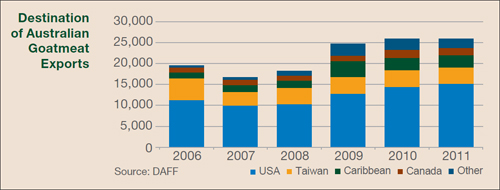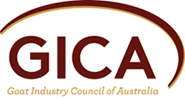Trade & Marketing
The overall supply of all goat products has increased significantly in the past decade and seems set for another decade of growth.
Working through research, development and marketing bodies such as Meat & Livestock Australia (MLA), GICA provides direction into developing and maintaining trade opportunities and marketing of goats and goat products.
Export goatmeat
Goatmeat is the meat of choice in many overseas countries and is the most widely consumed red meat in the world. Australia is well positioned, by virtue of a favourable production environment and a significant naturalised goat population, to supply this large and increasing global demand for goatmeat.
The Australian goatmeat industry has experienced a phase of dramatic growth in the last ten years with shipped weight exports increasing from 12,537 tonnes in 2000 to 25,911 tonnes in 2010.
Australia is the world’s largest exporter of goatmeat. While Australia exports to many countries, the USA continues to grow in dominance as the major driver behind the rapid growth in the Australian goatmeat industry.

The majority of goatmeat produced in Australia is exported as a commodity product and hence competes with other commodity products on the world market, particularly mutton. Consequently, mutton and goatmeat prices are closely correlated with commodity prices influenced by factors such as exchange rates.
Domestic goatmeat
The domestic market for goatmeat in Australia is small but growing. In 2011, the domestic goatmeat market accounted for approximately 10% of the total market, or the equivalent of 150,000 goats.
The commodity domestic market tends to be supplied with export-type product through indistinct supply chains whereas the premium domestic market is predominately supplied by producers or marketers who accumulate purpose bred meat goats from other producers to maintain supply volume.
Those producers and marketers supplying premium goatmeat report that domestic demand, particularly at the high end food service industry, well exceeds current supply and that the limited supply of suitable product is limiting market growth.
The premium domestic market typically tolerates more carcase fat than the export market making it well suited for supply by purpose-bred meat goats such as Boer or Boer cross animals.
Livestock export
Alongside the slaughter of goats for export and domestic consumption, considerable numbers of goats are exported live. In 2011, ABS reported that 71,895 goats were exported with the vast majority air freighted to Malaysia. While there has been strong demand for goats for breeding over the past 10 years, this has now abated with demand largely confined to slaughter animals. Find out more about the live export of goats.
Fibre
Mohair is the fleece produced by Angora goats. The characteristics of mohair that make it a sought after fibre are its lustre, soft handle, strength, elasticity and low felting properties. Mohair is also very durable, easy to clean, flame resistant, has a very high affinity for dyes and possesses both insulating and sound absorbance properties.
South Africa is by far the largest mohair-producing nation, accounting for over sixty percent of the world’s mohair clip. The United States of America is also a significant producer of mohair. Australia is currently only a small player on the world scene, contributing less than 5% of the world total.
Cashmere is produced by Cashmere goats and is recognised as one of the world’s premium fibres, being luxuriously soft, warm and light. It varies in colour from brown to light grey to white, and its diameter ranges between 11 and 20 micron.
The cashmere industry is small and very price sensitive with current levels of domestic production at around 10-12 tonne (including hair) per year. Global demand for cashmere exceeds supply which presents opportunities for the industry to develop.
Dairy
Production of dairy products from goats milk is a small but steady industry in Australia.
In 2009 there were approximately 65 commercial dairy goat farms, carrying close to 12,000 goats, and 15 factories processing goat milk in Australia.
Nearly one third of goat farms process their own milk but range considerably in size from farmhouse operations to relatively large processors.
Total production of milk is now about 6 million litres per annum of which around 60% goes into cheese production, 35% sold as whole milk, and the balance increasingly to powder. Total value of production is about $30 million.
The domestic market is growing steadily, particularly for specialty cheese, and domestic production is capturing an increasing share of this market from imported cheeses. Export activity is also growing.

